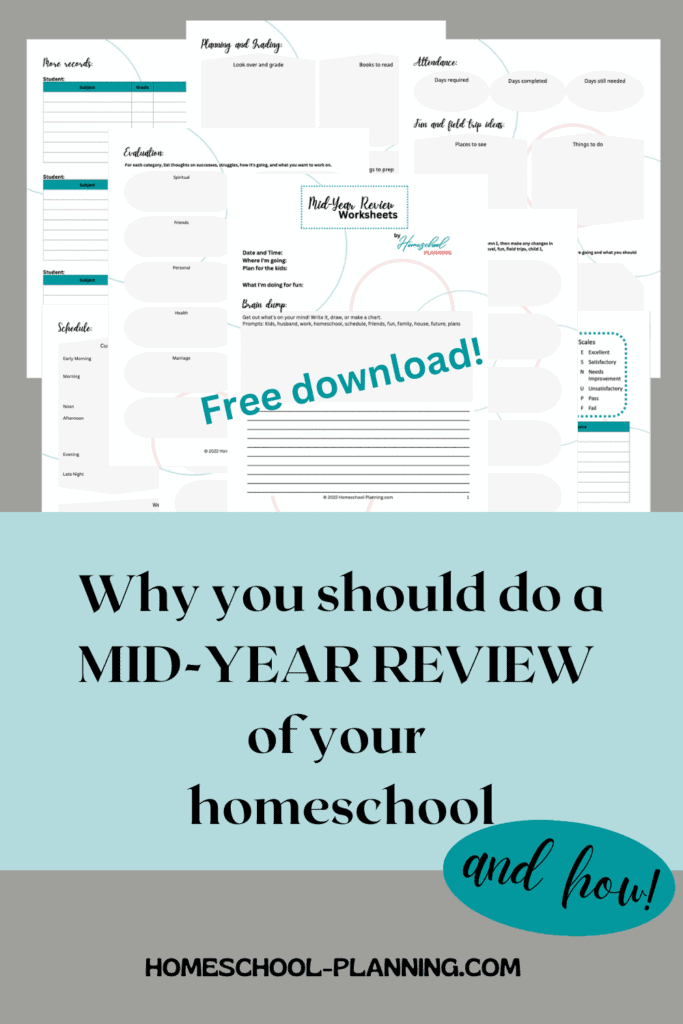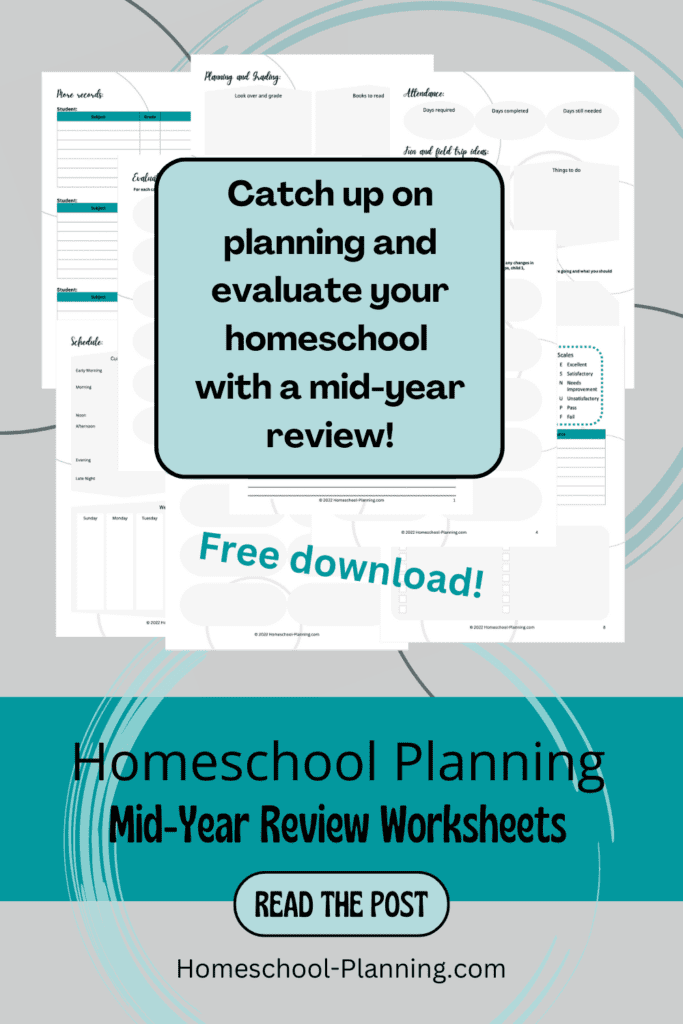Months have passed since you picked out the year’s curriculum and set out on the year’s journey of homeschool. You made goals and plans and set out with bright thoughts on all your kids will learn and do this school year.
But is it all still working? Are your kids getting what they need? Are your plans all awash now in the middle of the year? Let’s dig in to all those insecurities with a mid-year review of your homeschool!
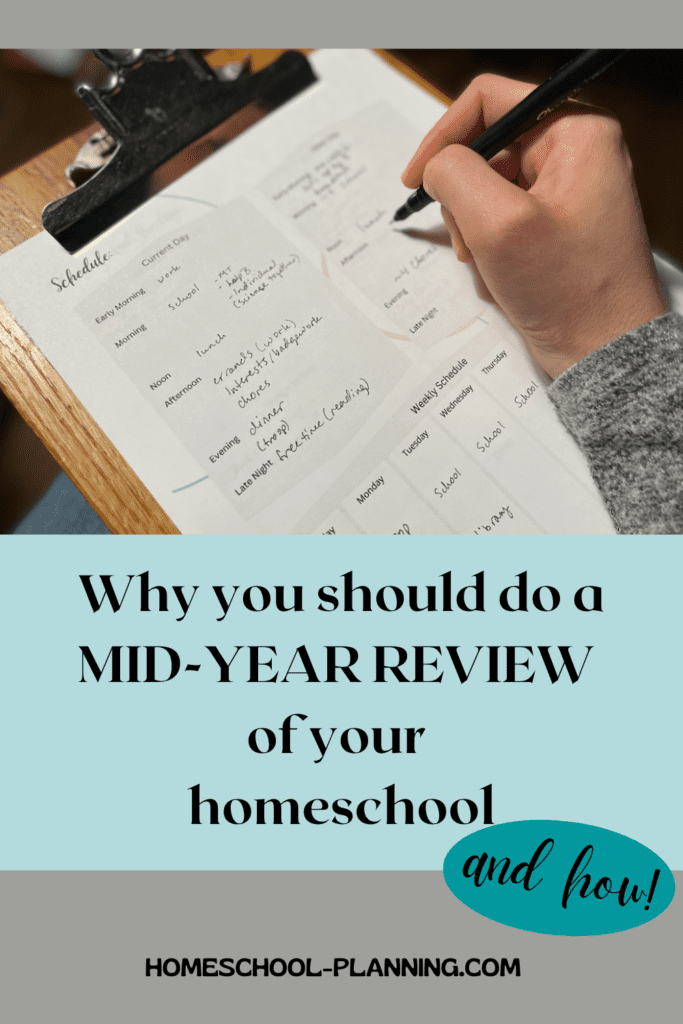
What is a mid-year review?
You can think of a mid-year review of your homeschool like an evaluation you may get at a traditional job. After several months on the job, your supervisor comes to be sure you are accomplishing all that you are supposed to be doing. They check on your work and see if you are meeting goals and check on your attitude about it all along the way.
That is what you can do with your homeschool in a mid-year review. Look at all your homeschool plans for year to see if you are meeting goals and objectives and if there are new developments or changes that need to be made.
It’s a check-up on the state of things in your homeschool. Sometimes the check-up is completed quickly and easily and sometimes it unearths some problems that need to be looked at further.
Why should I review my homeschool?
Occasional reviews of our homeschools should be done to ensure that the needs of our children are still being met. It’s always good to evaluate and see if you as the teacher think things are going well. This is the time to look into your day to day stresses and see if there are ways to improve.
One of my favorite college professors said all the time, “When it stops getting better, it stops being good.” The idea is that things grow stagnant when we just live our lives on autopilot. We must tend to things and always improve upon them.
If you take dedicated time to look at your homeschool, it can help you gain the focus and perseverance you need to keep going. It can help you reset mentally and work through any challenges you may not even realize you are facing.
If you are not setting dedicated time aside to plan and review the homeschooling of your children, then I’d venture to say you aren’t taking it seriously enough.”
When is a good time to evaluate my homeschool year?
There really is never a bad time to evaluate your homeschool year. It is great to briefly look over things in your homeschool every month or two throughout the school year.
Then once in the middle of the school year, do a larger mid-year review. At this point you can look over all your plans from beginning to end.
If your plans have been set up well, much of the year can go by without a hitch. And it is good to allow this to happen and continue life smoothly without analyzing every step you make in your homeschool.
You may troubleshoot problems that arise throughout the year, and focus in on those. But a big look at your entire homeschool is often not done for months.
In our homeschool, we officially start our new school year in July, so I like to evaluate our plans in early January or late December. I often take a couple weeks off school around Christmas time, so this is a good time for me to work in a mid-year review and planning time for our homeschool.

How to do a mid-year review
A mid-year review of your homeschool can be done in many ways and can cover many areas. Here are 11 things I think are important to cover in a mid-year evaluation of your homeschool.
1. Set time aside
To be successful at something, we need to dedicate time to it. If you are not setting dedicated time aside to plan and review the homeschooling of your children, then I’d venture to say you aren’t taking it seriously enough.
A mid-year review doesn’t have to take a huge chunk of time. But it does need your full attention. Start with setting aside a couple hours in your day and go from there. If you end up needing more time do all you have intended, find a few more hours at another time.
I have 3 kids and am big into planning, so I like to take several hours to work through all my thoughts and plans for our homeschool mid-year. Organizing other parts of our lives happens during this time as well.
I like to take my time on this. So that time is not full of hard work and drudgery, but a chance for me to reflect and reset my focus for our school year.

2. Do a brain dump
If you want to focus on something and do it well, one of the first things that’s helpful to do is a brain dump. Moms carry tons of stuff in our heads. Get it all out. Type it, write it, tell it to your mirror. Just get it out until you can think more clearly.
A brain dump doesn’t have to make sense. It doesn’t have to be pretty or easy. Get out your thoughts that are crowding your mind. You don’t have to deal with the thoughts yet, just get them out.
Most people write out their brain dumps. Putting things on paper allows you to truly let it go from your mind.
But your thoughts don’t have to be in journal form. Your brain dump might be:
- drawings
- charts
- web chart
- lists
- topical
- detailed
- vague
- nonsensical
- a combination of the above
There are no rules.
You may need some guidance to get started on a brain dump. That’s ok. Here are some topics to get you started. Just write down some thoughts on each one and see where it takes you.
- Kids
- Husband
- Work
- Homeschool
- Schedule
- Friends
- Fun
- Family
- House
- Future plans
If you haven’t done a brain dump in a while you may find you are more scattered. Or it may be hard to get started. Stick with it.
You may also find you want to dive further into a certain topic. Here’s an easy way to help you brainstorm. Go ahead. It’s worth it.

3. Evaluate
Evaluating your homeschool mid-year is a valuable way to check on your efforts. You are able to look at every area and see how things are going. Think about the things you have done, and compare all that to your original plans.
This is different from a brain dump. In a brain dump you are trying to empty your mind of the mess. It’s not usually organized. Evaluating is organized. You want to think about each topic in a certain way.
With each topic, write down how things are going. Write your successes. Your struggles. How you feel you are doing and maybe even things you want to do that you haven’t done.
As homeschool parents it’s difficult to separate homeschooling from our family life, so I tend to evaluate it all together initially then go a little deeper in some areas.
Here are some general topics you may want to cover in your evaluation:
- Spiritual
- Home
- Friends
- Family
- Personal
- Work
- Health
- Financial
- Marriage
- Focus for the season
- Homeschool
Once you have the general areas covered, you may want to dive in further on individual subject areas or children.
Think about how that subject is going, whether the curriculum is working, things you may want to tweak.
Also think about each of your children and how they are doing. Things they are struggling with, ways they are excelling. Is their curriculum working well for them? Do they have needs you want to consider this coming semester?
Evaluation of your year up to this point may seem like the main point of your mid-year review, but there is much more you should do to wrap things up.
Once you know how you’re doing, you have to apply those thoughts to your year and keep going!
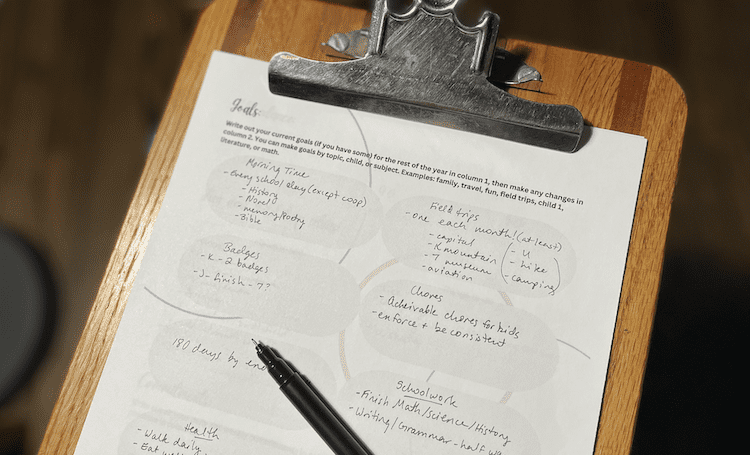
4. Review your goals
Remember all those big goals and plans you had for your school year? Have you looked at them recently? Pull those out now and take a look. Are you still on track?
Goals help us to remember what is important in our homeschool – if they’re done well of course.
Reviewing these goals may help you reset all the stresses you’ve put on yourself as a homeschool mom. They may take you back to the basics that are important to you.
But if your goals stress you out, then this is a good chance to rework them. Or maybe you should just start over from scratch!
Remember that this homeschooling thing is a marathon, not a sprint. You can’t do all the things every year.
And to really mess up that metaphor, I’ll add that it’s not a race at all. We’re not competing to produce the smartest kid. If that’s your goal, you should think long and hard about that. I think your ultimate goal should be to help your kids enjoy learning. Simple as that.
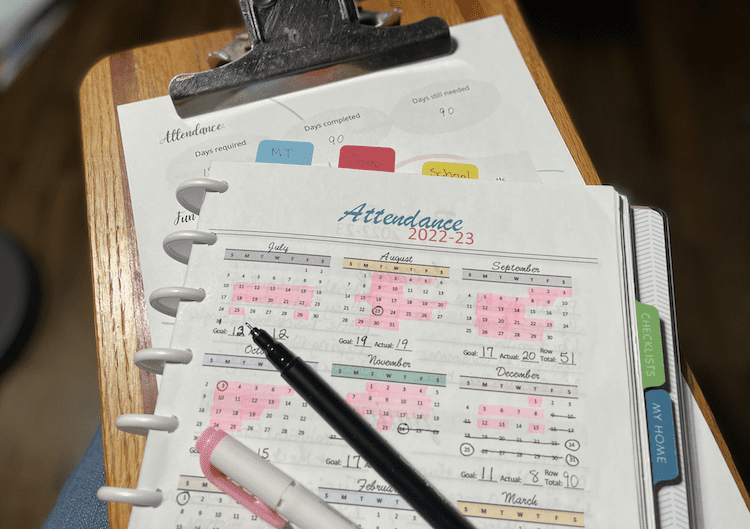
5. Update attendance
During a mid-year review is a good time to update your attendance records.
I recommend you keep track of this throughout the year. Some states require it and others don’t. But I find keeping records of the days you do school is helpful whether it’s required by law or not.
Keeping attendance is helpful for:
- planning out your school year and what you want to cover.
- making sure you are getting in a good amount of time learning throughout the year.
- backing you up legally if your homeschool efforts were ever challenged.
We start our homeschool each year in July so by the time I’m doing a review around the new year, we’ve usually gotten in around 90 days or so. My state requires 180 days a year, so that’s half way to my yearly goal – right on track.
I’ll be honest that sometimes it’s less than 90 and that’s ok. It seems like the fall semester is broken up with so many breaks and holidays it can be hard to get all our days. But I find during Winter I can often catch up on a lot of good school days. It works out in the end.
For more info on attendance records, like what to keep and how, check out my post on attendance records. You’ll find everything you need to know on tracking days and hours as well as ideas for schedules! Plus free trackers!
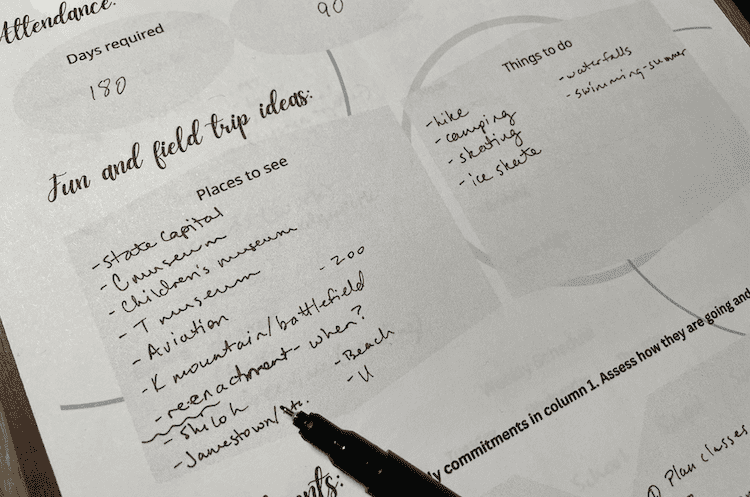
6. Add in fun stuff for kids
Sometimes we can get so caught up in the work of school, that we forget to have fun. I mean, truthfully, there is always soooo much to do, isn’t there?
But I don’t want my kids to grown up and remember me as a grumpy schoolmaster mom. I want to be a mom that helped them learn but also loved to be with them. So I try to remember to add in fun things to do together here and there in our homeschool life.
If fun isn’t easily on your radar, it’s ok to schedule it in. Plan in some fun stuff for your kids.
- Join a relaxed coop with fun classes
- Go on lots of field trips
- Go to a fun homeschool time at your local library
- Go skating
- Go bowling
- Play a board game
- Go on a hike with no agenda. (Don’t always kill the fun with a lesson!)
- Read a book together just because it’s a good book.
- And be there with your kids. Truly be there.
We are homeschoolers for a reason, and many do this so they can set their own schedule. So schedule in the fun stuff too.
Sarah Mackenzie from Read Aloud Revival does fun days like this and calls them “Just Because We Can” days. She schedules them in and has a good time with her kids. Your kids need more of this with you.
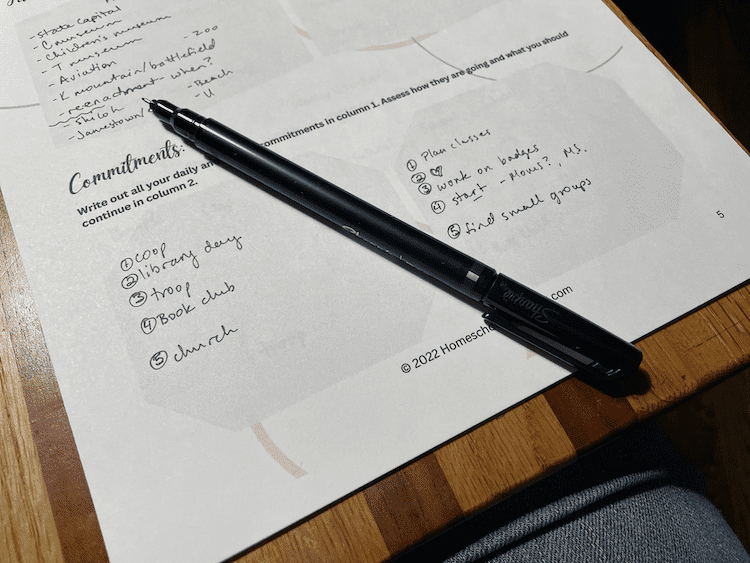
7. Reassess commitments
Are you constantly running around from place to place? Always stressed? Or maybe you have nothing going on and want to add in a thing or two to your schedule. Now’s a great time to look over all your commitments in your normal week and see if you need to make changes.
It’s ok to back off and let some things go. Remember your goals for the year. If some of your commitments don’t line up, let them go.
It’s important for your children to have unscheduled free time in their schedules. This allows time for pursuing interests and creativity. It also will reduce stress on all involved.
Maybe you’ve been wanting to look into a new activity but haven’t made the time. During your mid-year planning time is a great opportunity to do the research and make the calls to add things to your schedule.
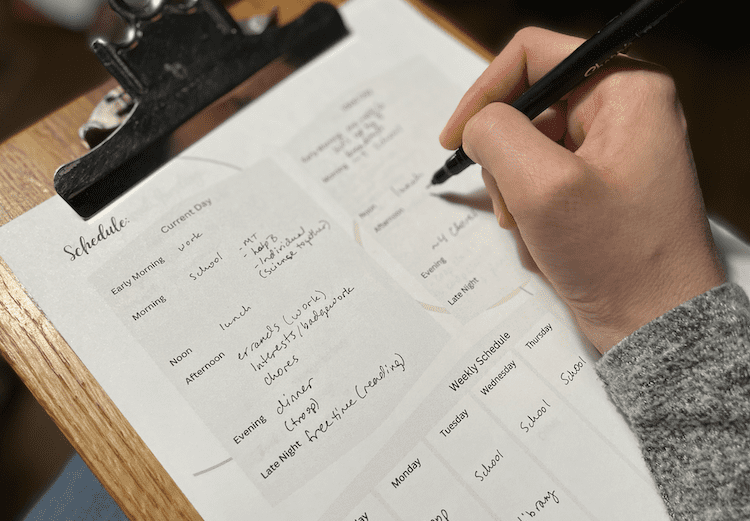
8. Check up on the schedule
It’s always a good idea to look over your schedule and see how things are working for you.
If your mornings are starting later and later each day, perhaps you need to buckle down again for a good start to your day. Or maybe you are being too strict, and could loosen things up a bit in your days.
Also check up on your monthly and weekly schedules. Are there certain days of the week you really struggle? You may need a later start time on some days or a lighter workload. Many even will homeschool 4 days a week to keep their sanity.
For more ideas on scheduling and attendance, check out my post on keeping attendance records.
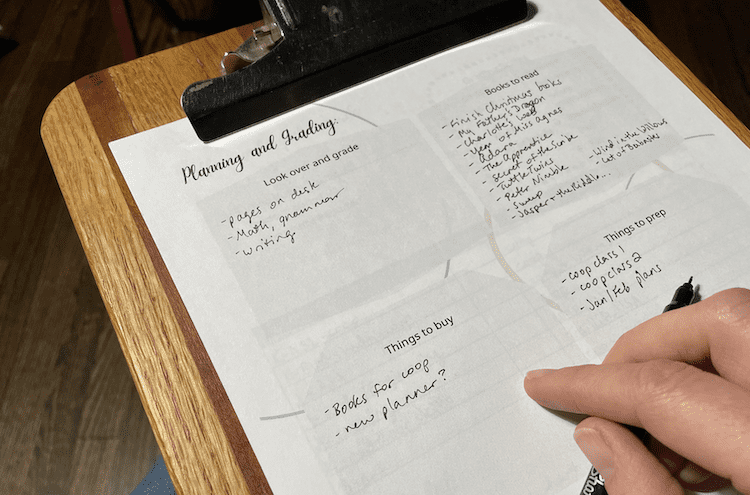
9. Catch up on planning and grading
When life gets crazy, it’s easy to put off the tedious things. If you’re anything like me, you may have a difficult time staying up on planning and record keeping in your homeschool. This mid-year review time is a great opportunity to catch up on all those things.
You’ve already got time set aside, so make the most of it and get caught up. Take care of your future self by making everything as pre-done as possible.
- Look forward a little and get your plans lined up for the next few weeks or months!
- Get caught up on any grading you’ve pushed aside.
- List out the books you want to read in the next couple months.
- Buy the science experiment supplies and look over the instructions.
- Get familiar with your upcoming unit study.
- Get a little ahead on planning coop classes you are teaching.
- Look over any writing assignments needed.
- Perhaps you have gotten “behind” in your plans for math, but “ahead” in English lessons. It’s a good time to tweak your lesson plans.
These are all great things to do now so your next couple months will require less thinking.
For some help organizing your homeschool and planning out your year, download my free homeschool planning pages by clicking this link!
Don’t even know where to start with homeschool planning? Check out my post about planning your homeschool year!

10. Gather and input records
Once you’re all caught up on the paperwork, you can actually gather and input those grades and attendance records! Some states in the US require that you submit grades and attendance mid-year. Whether this is required of you or not, it can be a great habit to practice.
Keeping grades for each semester can help many students stay motivated. It also may help you stay accountable to yourself by ensuring completion of school work. Grades are also an easy way to show others how and what your kids are doing in your homeschool.
Don’t get bogged down by this, especially for young children. “Satisfactory” and “excellent” are prefect for elementary students. You’re the teacher. Just give them a grade.
Here are some sample grading scales:
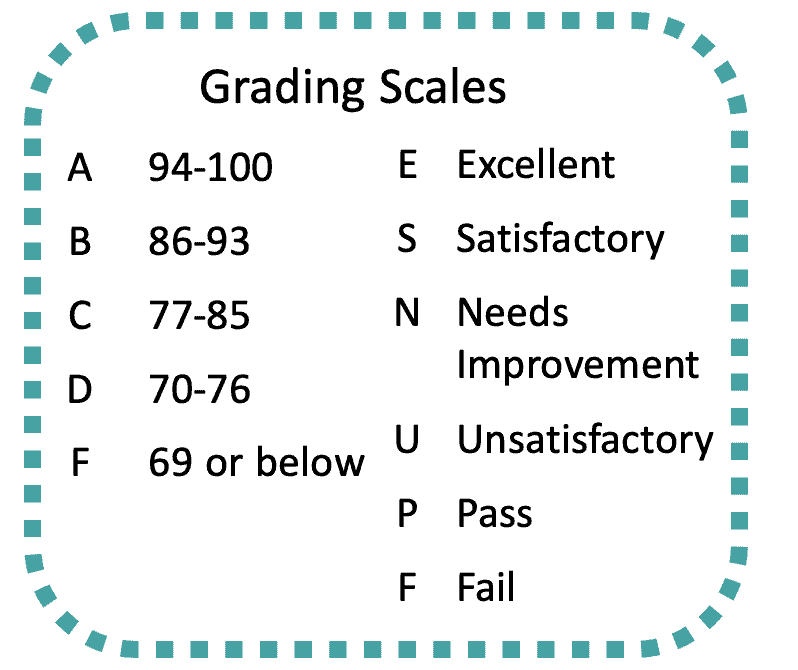
If you have to report semester grades and/or attendance records to your state or umbrella school, this is your reminder to get that done!
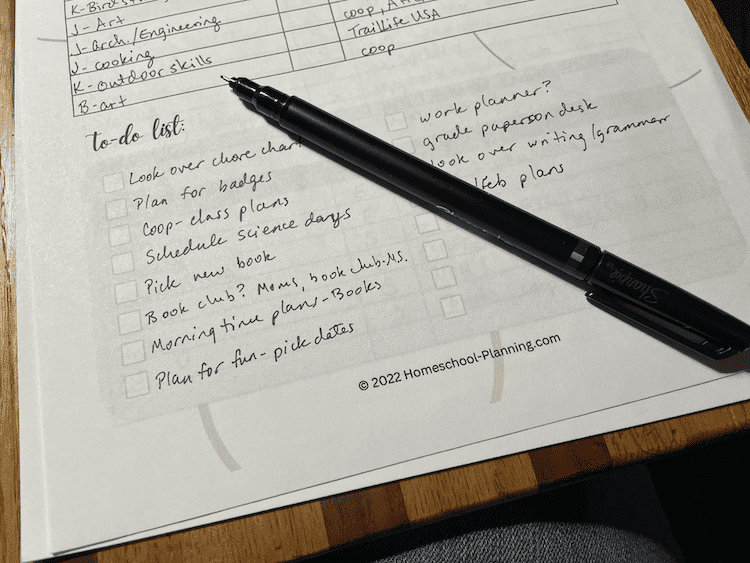
11. Make any changes needed
If during the course of your mid-year review you have decided there are some changes that need to be made, figure out a plan now to implement them. Don’t put this off till later. You have the time now.
I like to keep a running list of things I need to do as I go. This helps keep my mind from keeping the to-do list and also helps me not to miss things.
Did your brain dump bring up a list of tasks that need to be completed? Add those as well. Working on your goals and realize you should plan that out? Add it to your to-do list and keep working on your goals.
When you get to the end of all the other steps, you can take a look back through all you’ve done so far and be sure you haven’t missed anything. Then get to work on your to-do list.
Print out a new schedule, make the appointments, buy the books, sell the books, make the phone calls. Write out your plans to help them happen. Take care of your future self.
Free worksheets download

Want some free worksheets to help walk you through a mid-year homeschool review? I’ve created a free PDF download to guide you through all the steps in this post. Just download and print!
Tips for success
Here are a few quick tips to help make a mid-year review of your homeschool successful.
Have a plan
To make the best use of your time, it’s a good idea to have a plan. Homeschool moms don’t have a ton of extra time to mess around with, so being prepared for your time will help. Use my worksheets to help guide you.
Gather the things you’ll need in advance. Your planner, notebook, journal, pens, curriculum, whatever else you think will be helpful.
If you can, set time aside to get away by yourself. But know where you will go. Have someone set up to watch your kids. Start thinking about what you will cover. And know what kind of time you have before you need to get back home.
Getting all these things ironed out in advance will help you be able to focus well during the time you have.
Make it fun
Planning doesn’t have to be drudgery. Try to make it fun. Get yourself a treat while you’re out or make a little time for something you love. Getting together with a friend or two can also help you look forward to your planning and review time.
Check out my post on making your planning time less terrible for more ideas!
Don’t be in a rush
It’s important to take time for planning and review of your homeschool. Try not to rush it or just squeeze it in. Take some dedicated time out of your day and really focus on these things.
Homeschooling is your job right now, just like if you were a teacher in a regular school. Your class size may be smaller, but your impact is likely greater. Take this seriously and do it well.

Closing
Homeschooling your children is a big job and requires a good bit of thought and planning. Once you start your year and getting going, it’s not always smooth sailing.
A mid-year review of your homeschool is a fabulous way to look over all the parts of your homeschool life and see how things are going. Set yourself up for success in the months to come and evaluate your homeschool mid-year!

Related posts
Creating a Homeschool Teacher Retreat
How to make your homeschool planning time less terrible
23 Paper Homeschool Planners You’ll Love
The Best Online Homeschool Planners
